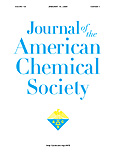







|
|
|
Journal
Publications |
|
Enantioselective Synthesis of
3,6-Dihydro-1H-pyridin-2-ones: Unexpected Regioselectivity in the
Palladium Catalyzed Decarboxylative Carbonylation of
5-Vinyloxazolidin-2-ones.
J.G. Knight, S.W. Ainge, A.M. Harm, S.J.
Harwood, H.I. Maughan, D.R. Armour, D.M. Hollinshead, and A.A.
Jaxa-Chamiec, J. Am. Chem. Soc.,
2000,
122, 2944. |
|
Abstract: Palladium catalysed
carbonylation [(Ph3P)2Pd(OAc)2 (5 mol%), CO (65 atm), EtOH, 70 oC, 5
days] of 5-ethenyl- and 5-(2-propenyl)-oxazolidin-2-ones gives rise to
3,6-dihydro-1H-pyridin-2-ones in 57-87% yields. The oxazolidinones are
prepared from alpha-amino acids by addition of vinyl Grignard reagents
to either the derived N-BOC-protected amino aldehydes or N-BOC-protected
Weinreb amides followed by sodium hydride mediated cyclization of the
resulting allylic alcohols. The enantiomeric purity of the valine-derived
products 3,6-dihydro-6-(2-propyl)pyridin-2-one and
3,6-dihydro-6-(2-propyl)-5-methylpyridin-2-one were studied by chiral GC
which showed that none of the enantiomeric pyridinones had formed during
the synthesis. The N-BOC protected species, N-(tert-butyloxycarbonyl)-5-ethenyl-4-phenylmethyloxazolidin-2-one,
did not produce the b-lactam under carbonylation in benzene and was
found to give the ethoxycarbonylated product, ethyl (3E,
5S)-5-N-(tert-butyloxycarbonyl)amino-6- phenylhex-3-enoate, in 48% yield
when ethanol was the solvent. The formation of the six-membered lactams
rather than the expected b-lactams from N-unprotected
vinyloxazolidinones may be due to initial formation of the b-lactam
followed by isomerization under thermodynamic control, or may result
from a thermodynamic preference for an anti-p-allyl palladium
intermediate from which ring closure to the d-lactam would be
geometrically favourable. |
| |
|
|
|



